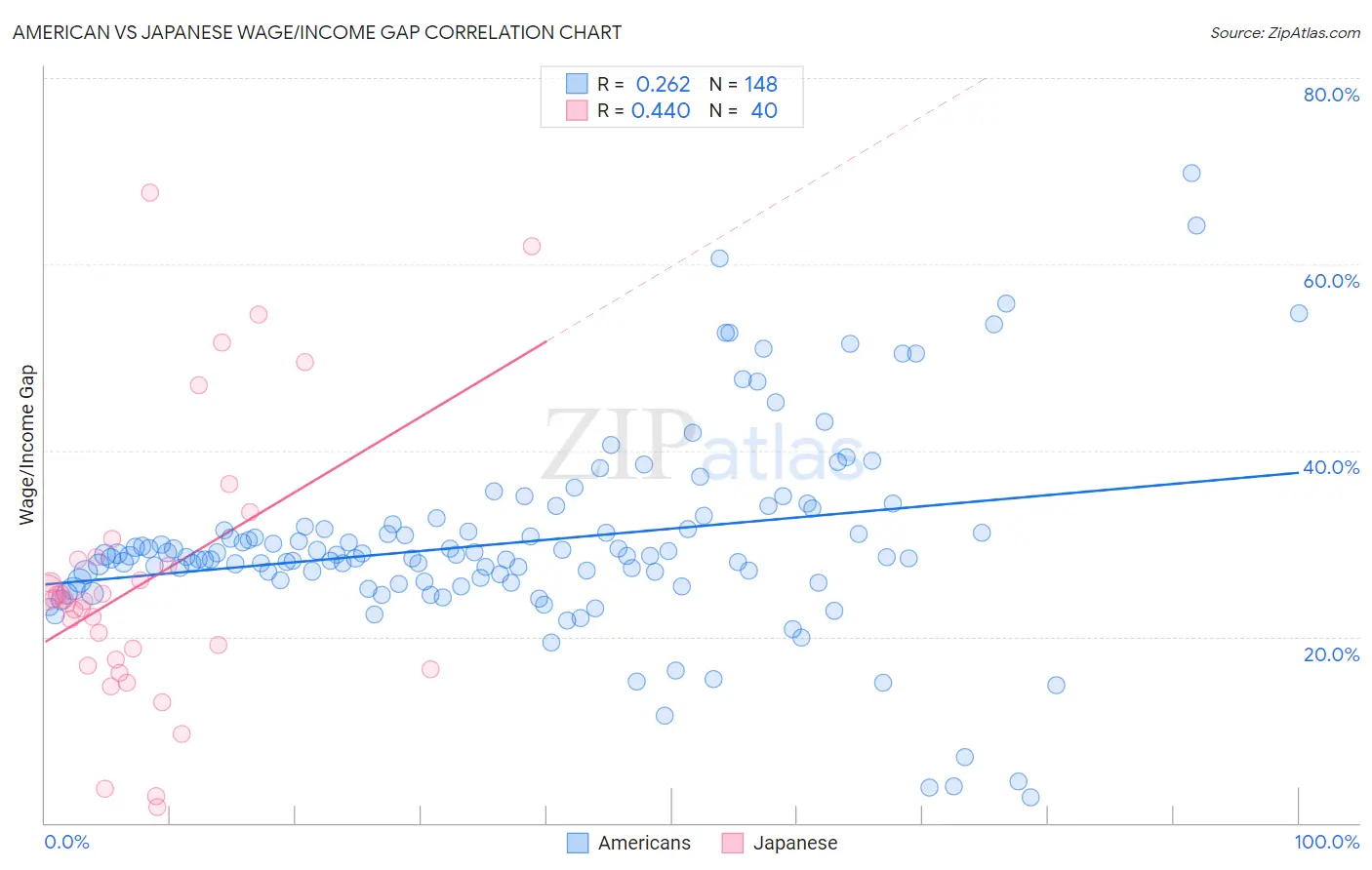American vs Japanese Wage/Income Gap
COMPARE
American
Japanese
Wage/Income Gap
Wage/Income Gap Comparison
Americans
Japanese
27.8%
WAGE/INCOME GAP
0.7/ 100
METRIC RATING
274th/ 347
METRIC RANK
23.8%
WAGE/INCOME GAP
99.1/ 100
METRIC RATING
101st/ 347
METRIC RANK
American vs Japanese Wage/Income Gap Correlation Chart
The statistical analysis conducted on geographies consisting of 577,977,110 people shows a weak positive correlation between the proportion of Americans and wage/income gap percentage in the United States with a correlation coefficient (R) of 0.262 and weighted average of 27.8%. Similarly, the statistical analysis conducted on geographies consisting of 249,130,971 people shows a moderate positive correlation between the proportion of Japanese and wage/income gap percentage in the United States with a correlation coefficient (R) of 0.440 and weighted average of 23.8%, a difference of 17.0%.

Wage/Income Gap Correlation Summary
| Measurement | American | Japanese |
| Minimum | 2.7% | 1.7% |
| Maximum | 69.8% | 67.8% |
| Range | 67.1% | 66.0% |
| Mean | 30.2% | 26.0% |
| Median | 28.7% | 23.9% |
| Interquartile 25% (IQ1) | 26.0% | 17.2% |
| Interquartile 75% (IQ3) | 31.7% | 28.4% |
| Interquartile Range (IQR) | 5.7% | 11.2% |
| Standard Deviation (Sample) | 10.5% | 14.8% |
| Standard Deviation (Population) | 10.5% | 14.6% |
Similar Demographics by Wage/Income Gap
Demographics Similar to Americans by Wage/Income Gap
In terms of wage/income gap, the demographic groups most similar to Americans are Bulgarian (27.8%, a difference of 0.040%), Immigrants from Japan (27.9%, a difference of 0.080%), Lebanese (27.9%, a difference of 0.11%), Latvian (27.9%, a difference of 0.11%), and Immigrants from Korea (27.8%, a difference of 0.15%).
| Demographics | Rating | Rank | Wage/Income Gap |
| Turks | 1.0 /100 | #267 | Tragic 27.7% |
| New Zealanders | 1.0 /100 | #268 | Tragic 27.7% |
| Potawatomi | 0.9 /100 | #269 | Tragic 27.7% |
| Immigrants | Western Europe | 0.9 /100 | #270 | Tragic 27.8% |
| Ute | 0.8 /100 | #271 | Tragic 27.8% |
| Immigrants | Korea | 0.8 /100 | #272 | Tragic 27.8% |
| Bulgarians | 0.7 /100 | #273 | Tragic 27.8% |
| Americans | 0.7 /100 | #274 | Tragic 27.8% |
| Immigrants | Japan | 0.7 /100 | #275 | Tragic 27.9% |
| Lebanese | 0.7 /100 | #276 | Tragic 27.9% |
| Latvians | 0.7 /100 | #277 | Tragic 27.9% |
| Immigrants | England | 0.6 /100 | #278 | Tragic 27.9% |
| Romanians | 0.5 /100 | #279 | Tragic 28.0% |
| Russians | 0.5 /100 | #280 | Tragic 28.0% |
| Burmese | 0.5 /100 | #281 | Tragic 28.0% |
Demographics Similar to Japanese by Wage/Income Gap
In terms of wage/income gap, the demographic groups most similar to Japanese are Immigrants from Laos (23.8%, a difference of 0.14%), Yakama (23.7%, a difference of 0.15%), Aleut (23.7%, a difference of 0.17%), Immigrants from Latin America (23.7%, a difference of 0.25%), and Tsimshian (23.9%, a difference of 0.37%).
| Demographics | Rating | Rank | Wage/Income Gap |
| Hondurans | 99.5 /100 | #94 | Exceptional 23.6% |
| Cape Verdeans | 99.4 /100 | #95 | Exceptional 23.6% |
| Kiowa | 99.4 /100 | #96 | Exceptional 23.6% |
| Immigrants | Sudan | 99.4 /100 | #97 | Exceptional 23.6% |
| Immigrants | Latin America | 99.2 /100 | #98 | Exceptional 23.7% |
| Aleuts | 99.2 /100 | #99 | Exceptional 23.7% |
| Yakama | 99.2 /100 | #100 | Exceptional 23.7% |
| Japanese | 99.1 /100 | #101 | Exceptional 23.8% |
| Immigrants | Laos | 99.0 /100 | #102 | Exceptional 23.8% |
| Tsimshian | 98.9 /100 | #103 | Exceptional 23.9% |
| Tlingit-Haida | 98.7 /100 | #104 | Exceptional 24.0% |
| Moroccans | 98.6 /100 | #105 | Exceptional 24.0% |
| Sudanese | 98.6 /100 | #106 | Exceptional 24.0% |
| Yaqui | 98.4 /100 | #107 | Exceptional 24.0% |
| Immigrants | Albania | 98.4 /100 | #108 | Exceptional 24.0% |